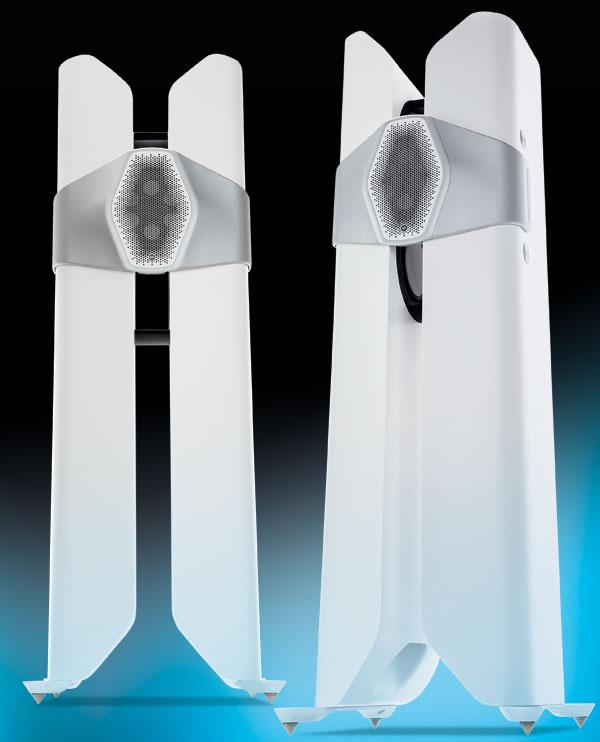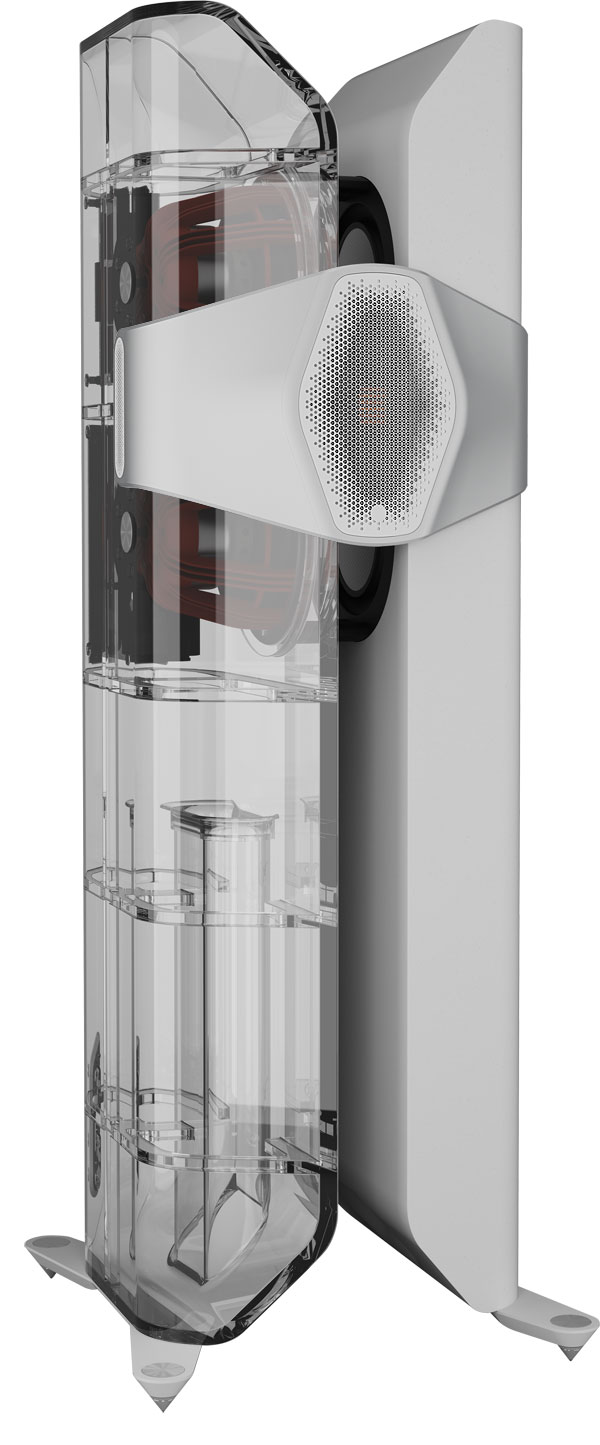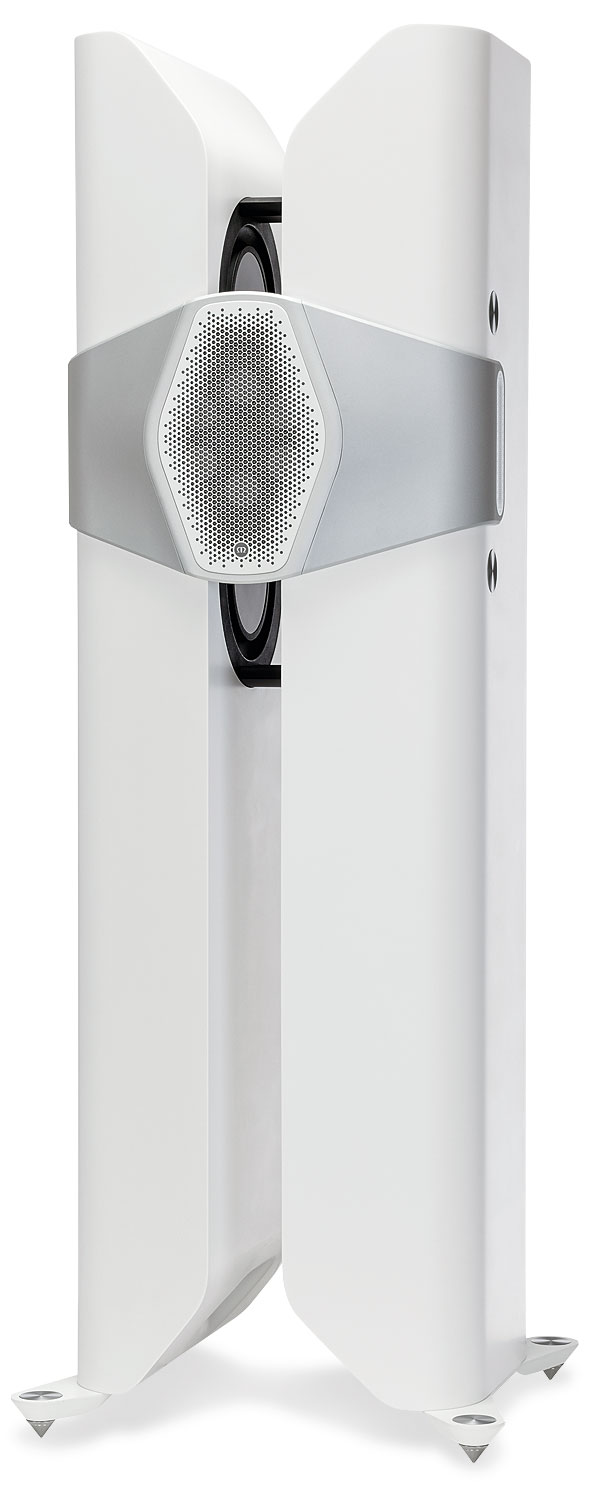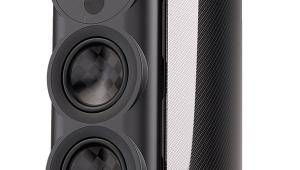Monitor Audio Hyphn Loudspeaker

 They started out as a Concept, and have become a reality combining a skeletal form and novel engineering solutions – but do they sound as other-worldly as they look?
They started out as a Concept, and have become a reality combining a skeletal form and novel engineering solutions – but do they sound as other-worldly as they look?
As safe bets go, that you've never seen anything quite like the £70k Monitor Audio Hyphn speaker is pretty much a dead cert. Yet look closer and there's actually a lot of 'form following function' going on here in those two columns with a gap between them, linked by a central belt. And while to unsympathetic eyes they may look like two huge clothes pegs, it won't take long for audiophiles to understand the thinking behind the configuration, however unusual the speakers look by comparison with traditional 'box, domes and cones' designs.
First seen at the 2022 High End Show in Munich, they created quite a stir. Then called Concept 50, they were due to go on sale by the end of last year to mark the company's half-century, it having been founded in 1972 by the irrepressible Mo Iqbal. Time has rolled on, and the speakers are finally here, the 'Concept' having become the Hyphn, and the reality being available in the matt white of that prototype, as well as matt black and 'Heritage Green', the last of these colours a deep, dark shade almost looking black.
What's In A Name?
Of course, the colour is really only a sideshow to the sheer visual impact of the Hyphns. The eye is immediately taken by those two mirror-image enclosures, formed from an exceptionally dense, rigid and 'dead' stone-like mix of mineral and acrylic that's heated and moulded into the required shape. Joining each of the speaker's two enclosures is a front-mounted 'belt', more of which later, which also informs the name: in architectural terms a 'hyphen' is a structure linking two larger edifices, such as the elevated 'Skybridge' between the Petronas Towers in Kuala Lumpur, Malaysia.

Each of the Hyphn's two pillars house a pair of opposing 200mm RDT III (Rigid Diaphragm Technology III) bass drivers, ported to a vent exiting via the cutaway base of each foot, supported by a pair of spiked, machined alloy outrigger feet. The bass array is designed to be force-cancelling, the horizontally-opposed bass units meaning, as the company puts it, that 'the unwanted vibrational energy each driver generates from an audio signal is cancelled by its opposing twin'.
The upright enclosures have a 12-24mm wall thickness, and include the ports and bracing moulded and machined into the material itself. The effect is impressive, that composite material feeling cool, smooth and reassuringly solid, whichever of the optional matt finishes one selects.
In the central 'belt' – and it does look rather like the waist-wear given to a boxer for winning a significant championship, with the subtle glint of the drivers behind their protective grille – is what the company calls its 'M-Array'. This combination of high and mid-frequency technology comprises a ring of six 50mm RDT III midrange drivers surrounding a single MPD (Micro Pleated Diaphragm) tweeter, making a total of 11 drivers in each speaker.
Divide And Conquer
Both midrange drivers and tweeter are in-house designs, the latest Rigid Diaphragm Technology diaphragms still employing MA's light and stiff ceramic-coated alloy but now both reinforced and damped by two rear layers of carbon-fibre. The six mid units combined offer a slightly greater driver area than the single 102mm RDT III midrange used in the latest Platinum 3G models, bringing with it advantages in both bandwidth (crossover design), reduced distortion and dispersion control. The MPD III treble driver, unveiled for Monitor Audio's 50th anniversary models, sits in its own waveguide and represents the apex of the brand's ultra-lightweight AMT/ribbon driver design.
Meanwhile, the belt itself features a 3D-printed resin 'acoustic enclosure' that sits within the machined alloy frame – all fixings being concealed by magnetically-attached metal panels on the outside face of each pillar.

This, then, is no minimalist speaker, from the sheer number of drivers to the design and construction of the whole enterprise. Of course, by locating those four bass drivers firing inwards into the gap between the two columns, and placing the mid/treble section in front, Monitor Audio is aiming at a 'point source' effect, where all frequencies appear to emanate from the same spot.
Concentric Questions
Other brands, including Tannoy, KEF, ELAC and, most recently, MoFi with its SourcePoint 10 [HFN Apr '23], use concentric mid/treble (or bass/mid and treble) driver arrays to achieve a truly coincident point source. Monitor Audio is not convinced, claiming that 'traditional dual concentric drivers add intermodulation distortion to the tweeter due to the displacement of the midrange diaphragm, which forms the tweeter waveguide. Monitor Audio's tweeter waveguide is fixed and the drivers create a flat baffle around the tweeter, [so] there is no additional IMD and the midrange can run to its full potential.'
The three-way crossover design has also witnessed more than a little fettling since the Concept 50's launch. Following a series of double-blind listening sessions at MA's HQ, the design team switched over to high-end Claritycaps and encapsulated inductors, the latter designed to reduce any vibrations in the windings.
The new crossover layout is split into HF, MF and LF sections to reduce interaction between the circuits while the PCB layouts have been further optimised for grounding and signal quality. Finally, the crossovers are now decoupled from the inside of the polymer/mineral cabinet to isolate the components as much as possible from any transmitted vibration.
It's quite safe to say that no other speaker quite looks like the Hyphn (inside or out) – it certainly makes quite an impact when installed in the listening room, standing almost 1.4m tall and weighing a considerable 107kg per speaker. As I mentioned in the opening paragraph, there's a real 'form following function' thing going on here, and while the styling is certainly exuberantly different, it's not hard to see where the Monitor Audio engineering team is coming from.

















































